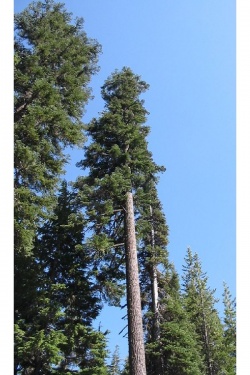Red fir
| Red Fir |
|---|

|
| Scientific Classification |
| Binomial Name |
|
Abies magnifica |
The Red fir is a species of firs native to the mountains of California and Oregon. Like all firs, the Red fir are ever greens and cone-bearing gymnosperms.
Anatomy
The red fir is a evergreen tree around 230 to 250 feet tall. Its trunk is around 15-20 feet in diameter when fully grown. The trunk of the tree is covered in blisters that are full of sticky resin called sap. In some parts of the country sap filled blisters become so cold they expand and explode sometimes causing the tree to break in half depending on the size of the tree. The leaves are needles and the cover the branches. The needle like leaves are used for water conservation and protection from animals that may want to eat them. They are flattened and about and inch long.
When the tree is young it has white or almost silver color to the bark but, when the tree matures the bark tends to turn a dark reddish brown making this a very colorful tree with its red bark and blue needles. The overall structure of the tree looks like a cone, sort of like the cones that the tree produces. It is a perennial tree, meaning that it grows for more than two years. Fir trees are gymnosperms meaning "naked seed" because seed is not protected by the cone but can be seen depending on the species. The seed, instead sits on one the outer scales of the cones or the inner depending on the species. The cones point up and release flying seeds near the beginning of winter or fall near the top of the tree. [1]
Reproduction
The Red Fir tree starts to produce seed when it is thirty to fifty years of age. The production of cones is limited to the top of the tree and it is rare that there are cones found near the bottom. In heavily forested areas the tree will lack lower branches because the branches do not get sunlight. The amount of cones produced depends on weather, size and even dominance over other trees. When the cone reach maturity winged seeds are produced and they begin to fall the ground or be carried off by the wind. They are light seeds and can make it very far just riding on the wind, sometimes for miles.
Germination begins when the snow melts or the beginning of spring. The survival of the seed depends on the placing of the seed when the snow was laid. The tree may die if the seed is to close to the surface where it can suffer cold temperature and other damages. For the first thirty years the tree grows extremely slow the as time goes on the tree begins to grow faster and faster. Some trees may reach one hundred and sixty feet tall.
Ecology
The red fir originated from the forests of Oregon and California. In these locations it is high elevation providing the right environment for this tree to grow. It is not often found in lower elevations. Forest fires destroy many of these trees in California and restart the process all over again. Due to high altitude this tree is used to cold and freezing temperatures and cannot survive in great heat or drought like conditions. Although during a few months of the year there are drought like conditions which the tree has to survive in. The fir can be spread around so sometimes it is often found in the middle of a bunch of other trees and thrive among them too. Most of the time though it is found in groups of the same species. The reason it likes to remain in it's own group is that, it can be dominant over the others.[2]
Varieties
There are two varieties of this species: Abies magnifica var. magnifica the Red Fir, and Abies magnifica var. shastensis the Shasta Red Fir. These two trees mainly differ in the cone plates (bract scales) and area of origin the red fir has large cones with elongated cone plates where the seeds are not visible when the cone has not opened. It comes from the Sierra Nevada region. The Shasta Red Fir has elongated cone plates just as the Red Fir, but the seeds are visible. It is thought that maybe the Shasta Red Fir is a hybrid of the Red Fir. It comes from Southwest Oregon and Northwest California. [3]
References
- Red Fir Wikipedia. Multiple.
- Abies magnifica USDA
- Abies PageAbies maginifica A
- DatabaseGymnosperm Database
 Browse |





